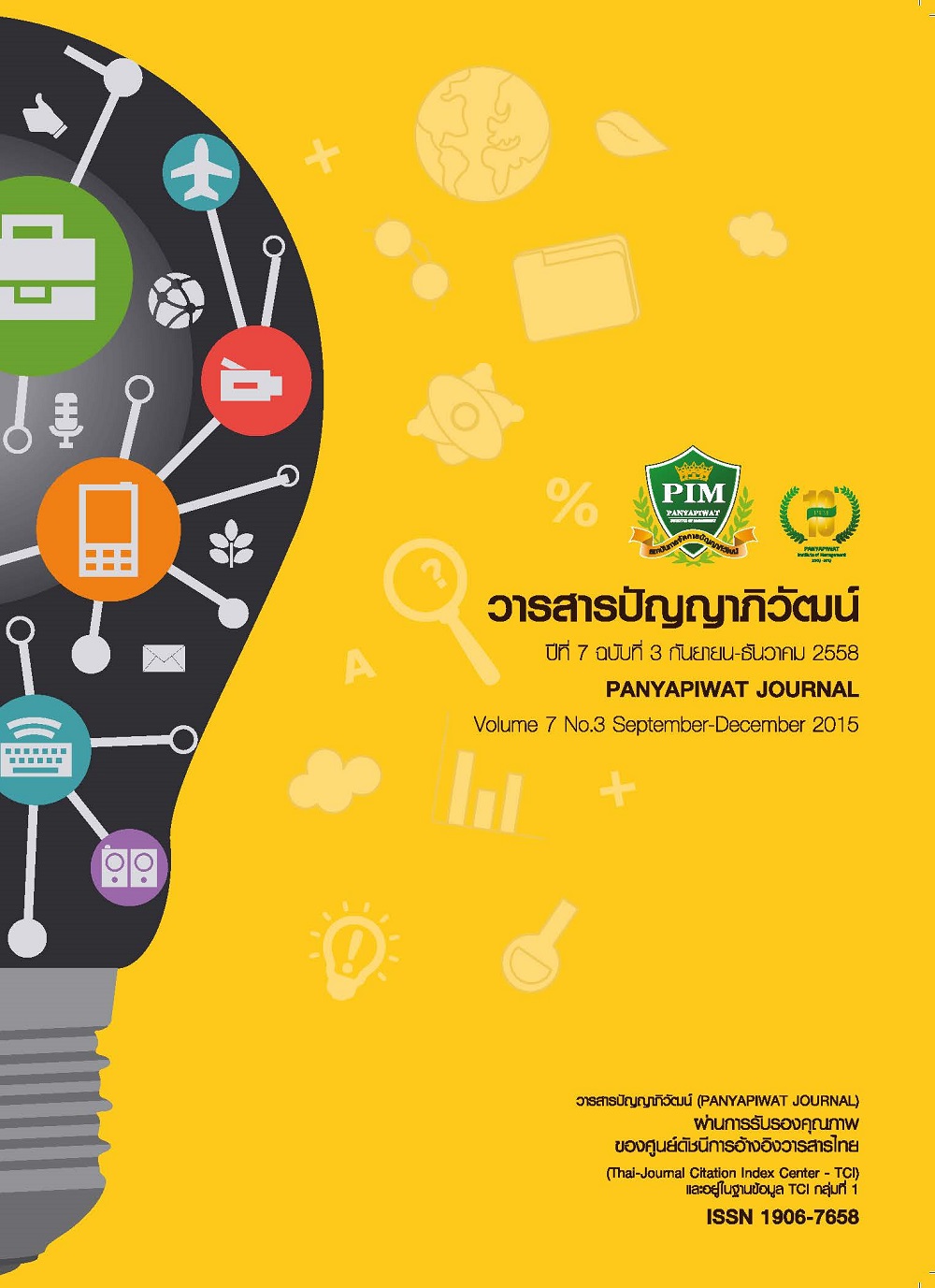การลดช่องว่างระหว่างรัฐกับประชาชนด้วยการใช้รัฐอิเล็กทรอนิกส์
Main Article Content
บทคัดย่อ
การวิจัยเรื่อง การลดช่องว่างระหว่างรัฐกับประชาชนด้วยการใช้รัฐอิเล็กทรอนิกส์ มีวัตถุประสงค์ในการศึกษาเพื่อปัจจัยต่างๆ ในส่วนของเทคโนโลยีสารสนเทศของหน่วยงานภาครัฐปัจจุบันที่มีความสัมพันธ์กับการลดช่องว่างระหว่างประชาชนที่มีต่อหน่วยงานภาครัฐเก็บข้อมูลจากเจ้าหน้าที่ศูนย์เทคโนโลยีอิเล็กทรอนิกส์และคอมพิวเตอร์แห่งชาติจำนวน 426 คน
ผลการวิจัย พบว่า ผู้ตอบแบบสอบถามส่วนใหญ่เป็นเพศชาย มีอายุ 31-40 ปี การศึกษาในระดับปริญญาโท และปฏิบัติงานในระดับผู้ปฏิบัติงาน มีรายได้ต่อเดือนระหว่าง 20,000-40,000 บาท ประเด็นที่เกี่ยวข้องกับเทคโนโลยีสารสนเทศและรัฐอิเล็กทรอนิกส์ หากเรียงลำดับความเหมาะสมของเทคโนโลยีสารสนเทศและรัฐอิเล็กทรอนิกส์จากหัวข้อที่มีความเหมาะสมสูงกว่าไปหาความเหมาะสมต่ำกว่า ได้แก่ 1) นโยบายของภาครัฐที่มีต่อการขับเคลื่อนรัฐอิเล็กทรอนิกส์ 2) การลงทุนในส่วนของเทคโนโลยีสารสนเทศ 3) ความรู้ความเข้าใจในเทคโนโลยีสารสนเทศของประชาชน 4) ความรู้ความเข้าใจในการใช้เทคโนโลยีสารสนเทศของเจ้าหน้าที่รัฐ 5) ระบบเครือข่าย 6) การประชาสัมพันธ์ในการให้ประชาชนเข้าถึงรัฐอิเล็กทรอนิกส์ ประเด็นของรัฐอิเล็กทรอนิกส์ในการลดช่องว่างระหว่างรัฐกับประชาชน หากเรียงลำดับความสามารถของรัฐอิเล็กทรอนิกส์จากหัวข้อที่มีความสามารถสูงกว่าไปหาความสามารถต่ำกว่า ได้แก่ 1) คุณภาพ 2) ประสิทธิภาพ 3) ความสะดวก 4) ประโยชน์
ผลการทดสอบสมมติฐานด้วยไคแสคว์ (Chi-square) พบว่า การลงทุนในส่วนของเทคโนโลยีสารสนเทศ ความรู้ความเข้าใจของพนักงาน การประชาสัมพันธ์ ระบบเครือข่าย และนโยบายภาครัฐที่มีต่อการขับเคลื่อนรัฐอิเล็กทรอนิกส์มีความสัมพันธ์กับการลดช่องว่างระหว่างรัฐและประชาชน มีเพียงความรู้ความเข้าใจของประชาชนที่ไม่มีความสัมพันธ์ และเมื่อวิเคราะห์จำแนก (Discriminant analysis) เพื่อวิเคราะห์ปัจจัยที่สามารถจำแนกความสามารถในการลดช่องว่างระหว่างรัฐและประชาชน พบว่า ปัจจัยทั้ง 6 สามารถจำแนกความสามารถในการลดช่องว่างระหว่างรัฐและประชาชน โดยสามารถพยากรณ์ได้ถูกต้องโดยรวม ร้อยละ 93 สามารถเขียนสมการจำแนกได้ดังนี้
ZY = 0.307ZX1 + 0.705ZX2 - 0.301ZX3 + 0.784ZX4 - 0.671ZX5 + 0.486ZX6
The research Closing the Gap between Public and Citizen: An Approach of Electronic Government, the objectives of this study was to investigate the factors about the technology of current government relate to decrease the gap between public and citizen. Data from 426 staffs of the National Electronics and Computer Technology Center: NECTEC,
The research found the majority of respondents were male, between 31-40 years with postgraduate level and work in the operational level with a monthly income between 20,000 - 40,000 Baht. The results could ordered the issues related to information technology and electronic government from the most to the less appropriate: 1) the government policy towards the e-Gov policy 2) investment in ICTs 3) public cognitive in ICTs 4) knowledge of government employee in ICTs 5) networking 6) public relations about e-Gov projects. The results could order the issues of electronic government to close the gap between public and citizen from the most to the less capacity: 1) quality 2) performance 3) Features 4) advantage.
Hypothesis testing with Chi-Square found that the government policy towards the e-Gove policy, investment in ICTs, knowledge of government employee in ICTs, networking and public relations about e-Gov projects except public cognitive in ICTs correlates with the closing gap between public and citizen. Using discriminant analysis to analyze the factors that distinguish the ability to closing the gap between public and citizen found that the six factors can be identified, the ability to closing the gap in overall predictive accuracy of 93 percent, which can be classified into the following equation:
ZY = 0.307ZX1 + 0.705ZX2 - 0.301ZX3 + 0.784ZX4 - 0.671ZX5 + 0.486ZX6
Article Details
“ข้าพเจ้าและผู้เขียนร่วม (ถ้ามี) ขอรับรองว่า บทความที่เสนอมานี้ยังไม่เคยได้รับการตีพิมพ์และไม่ได้อยู่ระหว่างกระบวนการพิจารณาลงตีพิมพ์ในวารสารหรือแหล่งเผยแพร่อื่นใด ข้าพเจ้าและผู้เขียนร่วมยอมรับหลักเกณฑ์การพิจารณาต้นฉบับ ทั้งยินยอมให้กองบรรณาธิการมีสิทธิ์พิจารณาและตรวจแก้ต้นฉบับได้ตามที่เห็นสมควร พร้อมนี้ขอมอบลิขสิทธิ์บทความที่ได้รับการตีพิมพ์ให้แก่สถาบันการจัดการปัญญาภิวัฒน์หากมีการฟ้องร้องเรื่องการละเมิดลิขสิทธิ์เกี่ยวกับภาพ กราฟ ข้อความส่วนใดส่วนหนึ่งและ/หรือข้อคิดเห็นที่ปรากฏในบทความข้าพเจ้าและผู้เขียนร่วมยินยอมรับผิดชอบแต่เพียงฝ่ายเดียว”
เอกสารอ้างอิง
วีระศักดิ์ เชิงเซาว์. (2556). นโยบายการบูรณาการด้าน ICT และการจัดสรรงบประมาณของหน่วยงานภาครัฐ. สืบค้นเมื่อ 12 กันยายน 2557, จาก http://www.prd.go.th/ewt dt link.php?nid=19565&filename=expert
ศูนย์เทคโนโลยีอิเล็กทรอนิกส์และคอมพิวเตอร์แห่งชาติ. (2555). สืบค้นเมื่อ 12 กันยายน 2557, จาก http://www.nectec.or.th/index.php/2011-07-11-04-40-31/2011-05-12-07-55-01.html
สถาบันนวัตกรรมเทคโนโลยีสารสนเทศ. (2556). กิจกรรมการศึกษาแนวทางการขับเคลื่อนการพัฒนารัฐบาลอิเล็กทรอนิกส์ของประเทศไทย ภายใต้โครงการส่งเสริมศักยภาพบุคคลด้านนโยบายเทคโนโลยีสารสนเทศและการสื่อสารของประเทศไทย. กรุงเทพฯ: มหาวิทยาลัยเกษตรศาสตร์.
สถาบันเทคโนโลยีสารสนเทศนวัตกรรม. (2556). Educational Activities Driven Approach to e-Government Development in Thailand. รายงานการวิจัย กรุงเทพฯ: มหาวิทยาลัยเกษตรศาสตร์.
สํานักข่าวแห่งชาติ กรมประชาสัมพันธ์. (2554). ศูนย์เทคโนโลยีอิเล็กทรอนิกส์และคอมพิวเตอร์แห่งชาติเชื่อว่าเทคโนโลยีระบบ 3 จีจะช่วยให้การสื่อสารของผู้พิการทางหูสะดวกมากขึ้น สืบค้นเมื่อ 20 ตุลาคม 2557,จาก http://www.braille-cet.in.th/Braille-new/?q=article-2279
สํานักงานรัฐบาลอิเล็กทรอนิกส์ (2554). บริการเครือข่ายสื่อสารข้อมูลเชื่อมโยงหน่วยงานภาครัฐ. สืบค้นเมื่อ 12 กันยายน 2557, จาก http://webcache.googleusercontent.com/search?q=cache:cs fYk mNrEU:www.ega.or.th/Content.aspx%3Fm_id%3D62+&cd=1&hl=th&ct=clnk&gl=th
สํานักงานรัฐบาลอิเล็กทรอนิกส์ (2554), ประวัติความเป็นมา. สืบค้นเมื่อ 12 กันยายน 2557, จาก http://webcache.googleusercontent.com/search?q=cache:-qVGiXjlmZIJ: www.ega.or.th/Content.aspx%3Fc_id
%3D651+&cd=1&hl=th&ct=clnk&gl=th
สํานักงานสถิติแห่งชาติ. (2556). การมีการใช้เทคโนโลยีสารสนเทศและการสื่อสารในครัวเรือน พ.ศ. 2556. กรุงเทพฯ
กระทรวงเทคโนโลยีสารสนเทศและการสื่อสาร อุทัย เลาหวิเชียร. (2540). รัฐประศาสนศาสตร์ ลักษณะวิชาและมิติต่างๆ. กรุงเทพฯ:
สํานักพิมพ์เสมาธรรม
Ott, J. S., Hyde, A. C. & Shafritz, J. M. (2011). Public Management The Essential Readings. Chicago:Lyceum Books/Nelson-Hall Publishers.
Rosenbloom, D. H. & Kravchuk, R. S. (2005). Public Administration: Understanding Management,Politics, and Law in the Public Sector. OH: Mc-Graw Hill.
Translated Thai References
Cherngchao, V. (2013). Integration Policy of ICT and Budget Allocation by the Government. Retrieved September 12, 2014, from http://www.prd.go.th/ewt_dl_link.php?nid=19565&filename=expert [in Thai]
Electronic Government Agency. (2011). About Us. Retrieved September 12, 2014, from http://webcache.googleusercontent.com/search?q=cache:-qVGiXjlmZIJ: www.ega.or.th/Content. aspx%3Fc id%3D651+&cd=1&hl=th&ct=clnk&gl=th [in Thai]
Electronic Government Agency. (2011). Government Information Network: GIN. Retrieved September12, 2014, from http://webcache.googleusercontent.com/search?q=cache:cs fyk mNrEJ:www.ega.or.th/Content.aspx%3Fm id%3D62+&cd=1&hl=th&ct=clnk&gl=th [in Thai]
Institute of Innovation and Technology. (2013). Activities Correspond to Driving the Development of e-Government under the Project, Developing Human Resources, Information Technology and Communication Policy in Thailand. Bangkok: Kasetsart University. [in Thai]
Institute of Innovation and Technology. (2013). Research of Educational Activities Driven Approach to e-Government Development in Thailand. Bangkok: Kasetsart University. [in Thai]
Laohavichean, U. (1997). Field and Dimension of Public Administration. Bangkok: Sematham Publish. [in Thai]
National Electronics and Computer Technology Center. (2012). Retrieved September 12, 2014,from http://www.nectec.or.th/index.php/2011-07-11-04-40-31/2011-05-12-07-55-01.html [in Thai]
National News Bureau of Thailand. (2011). National Electronics and Computer Technology Center believed that 3G technology allows the communication of the deaf. Retrieved October 20, 2014, from http://www.braille-cet.in.th/Braille-new/?q=article-2279 [in Thai]
National Statistics Office. (2013). ICT Usage Survey, Thailand 2013. Bangkok: Ministry of Information and communication Technology. [in Thai]


